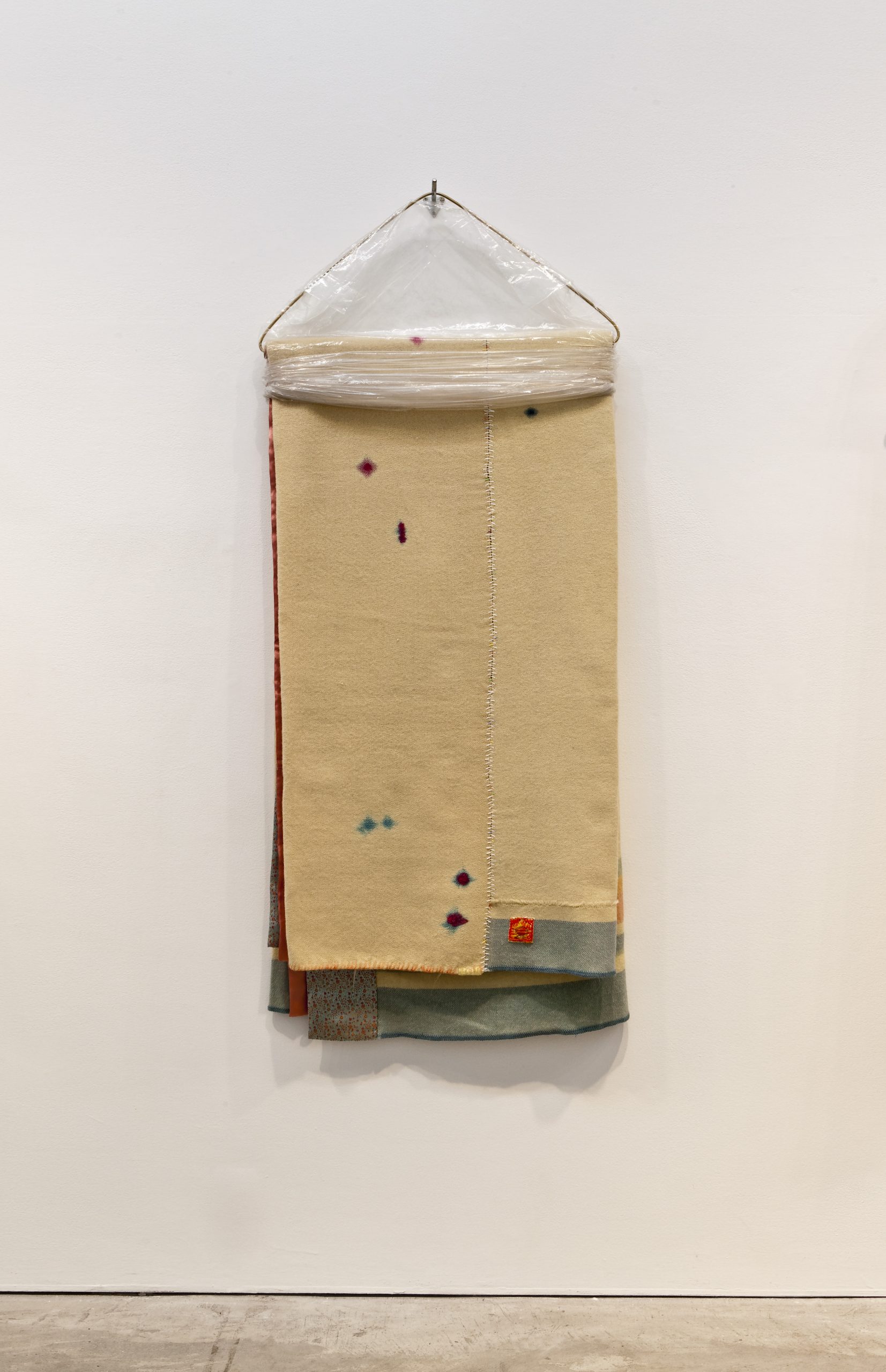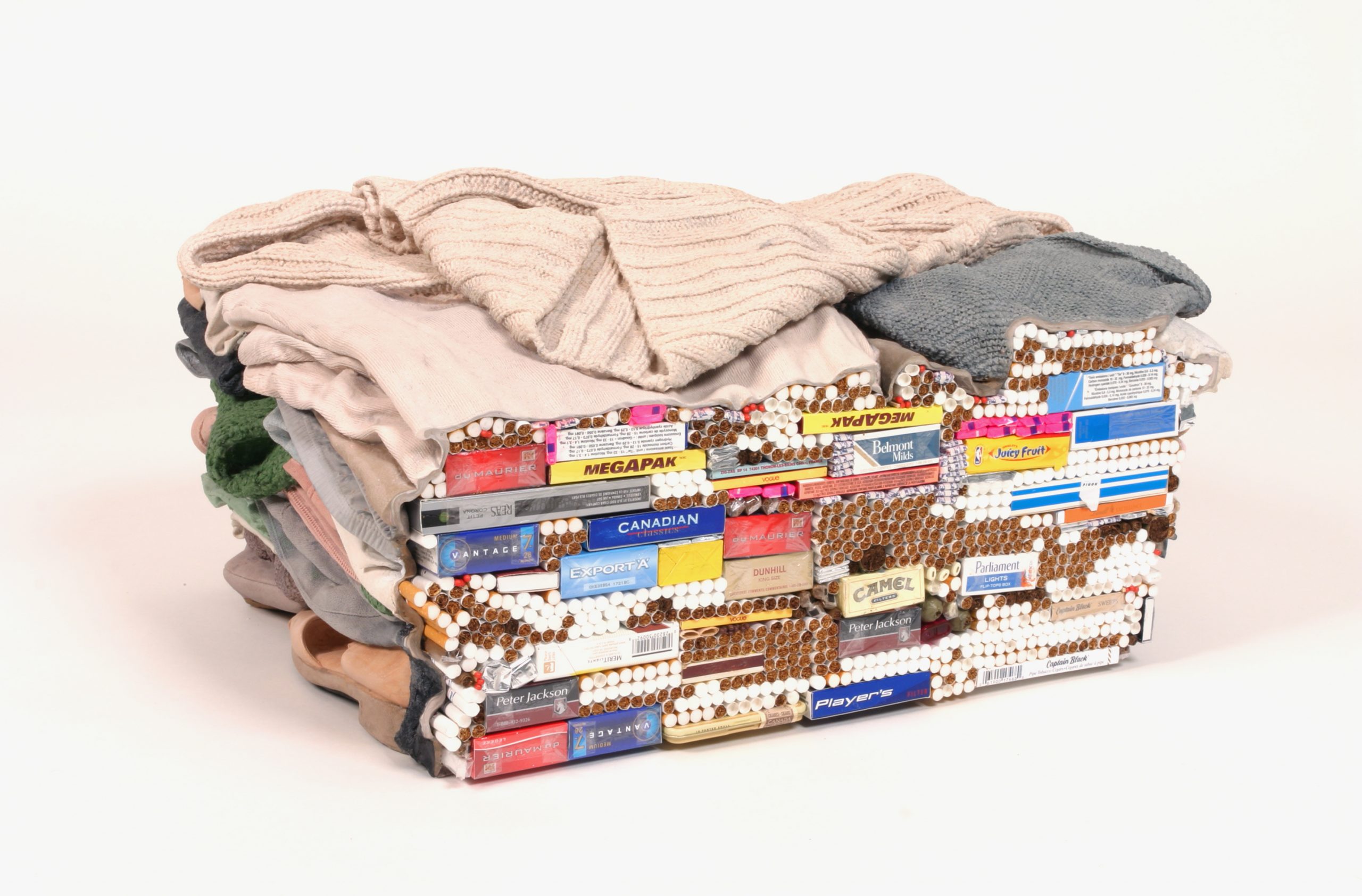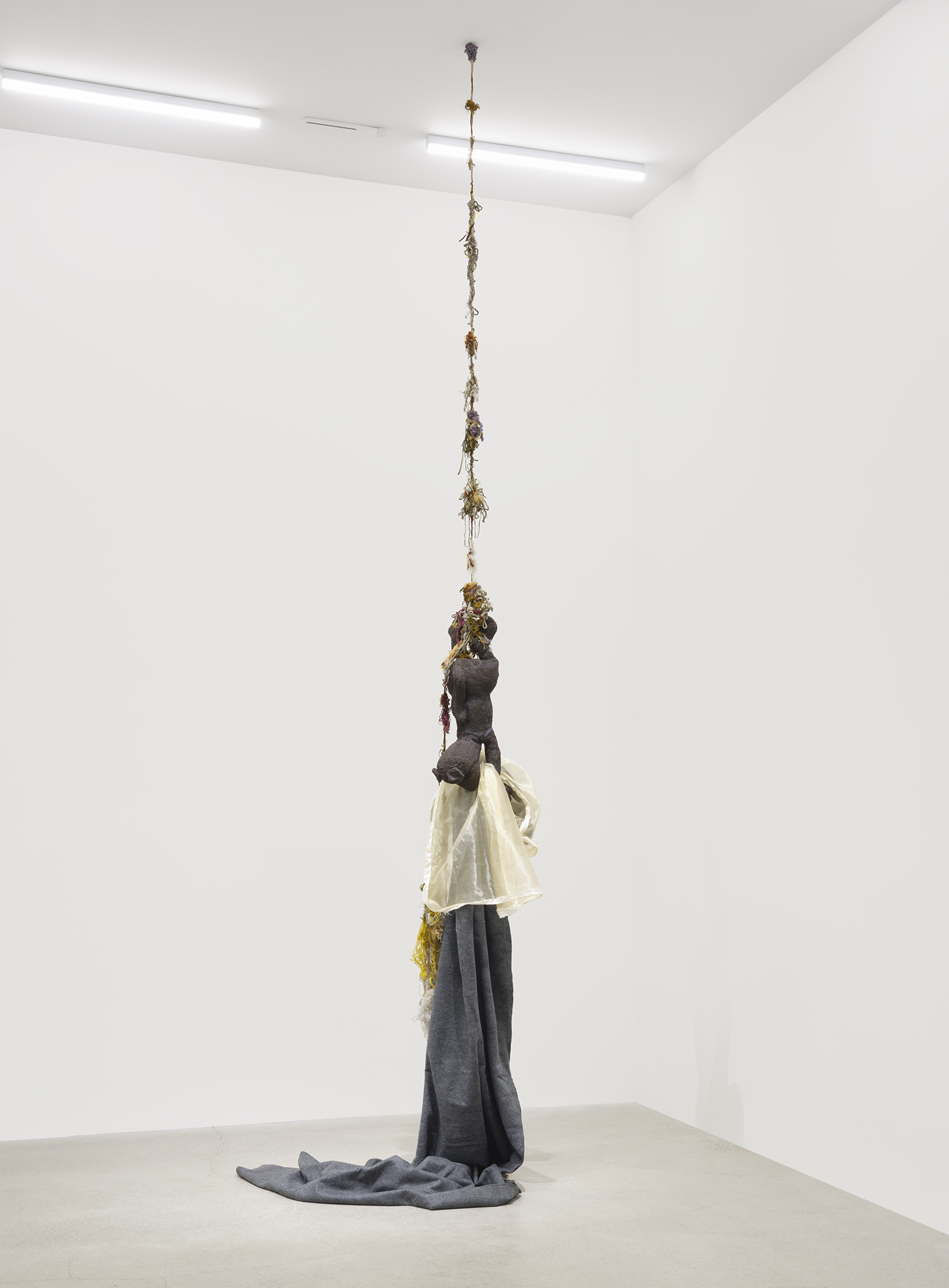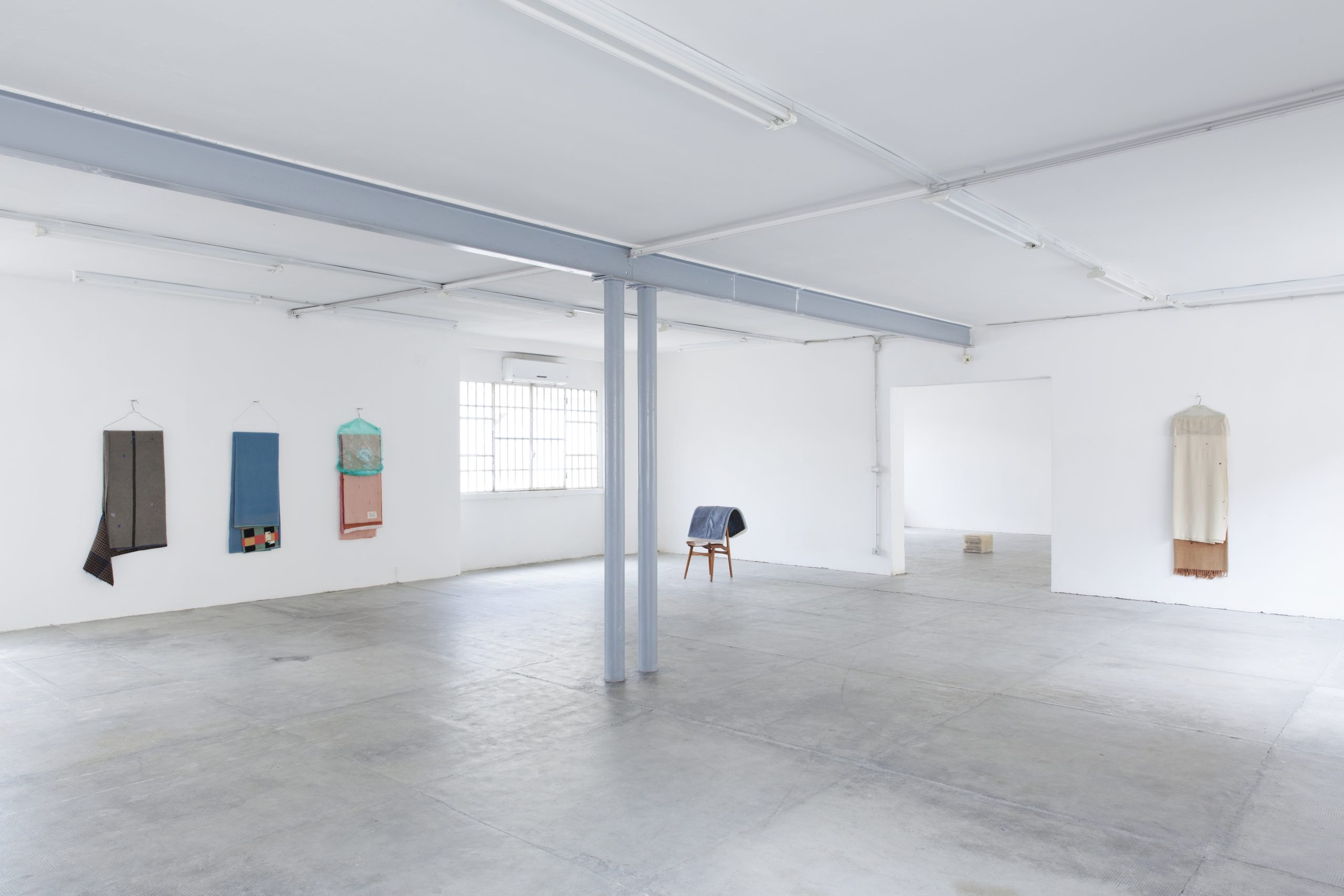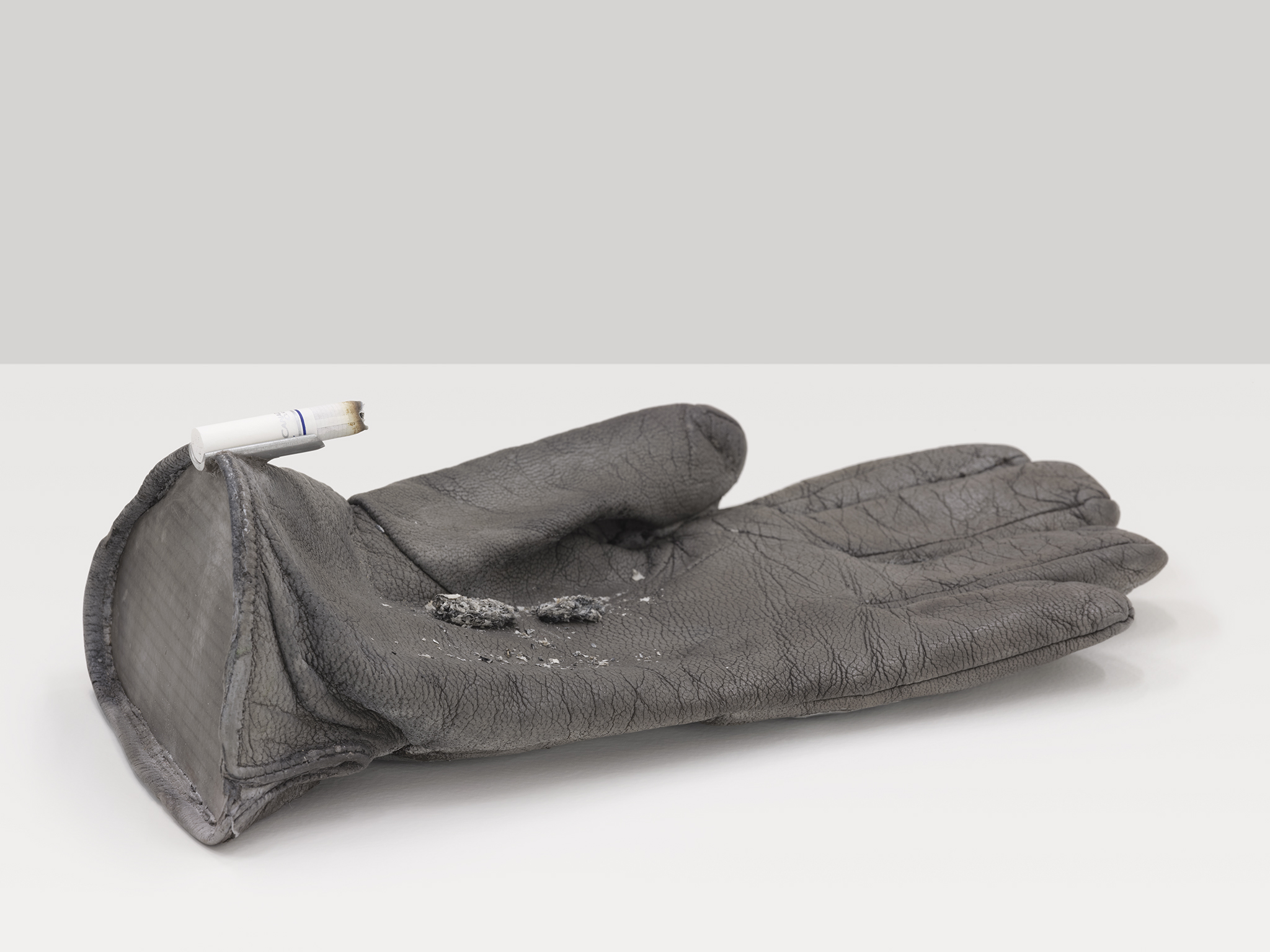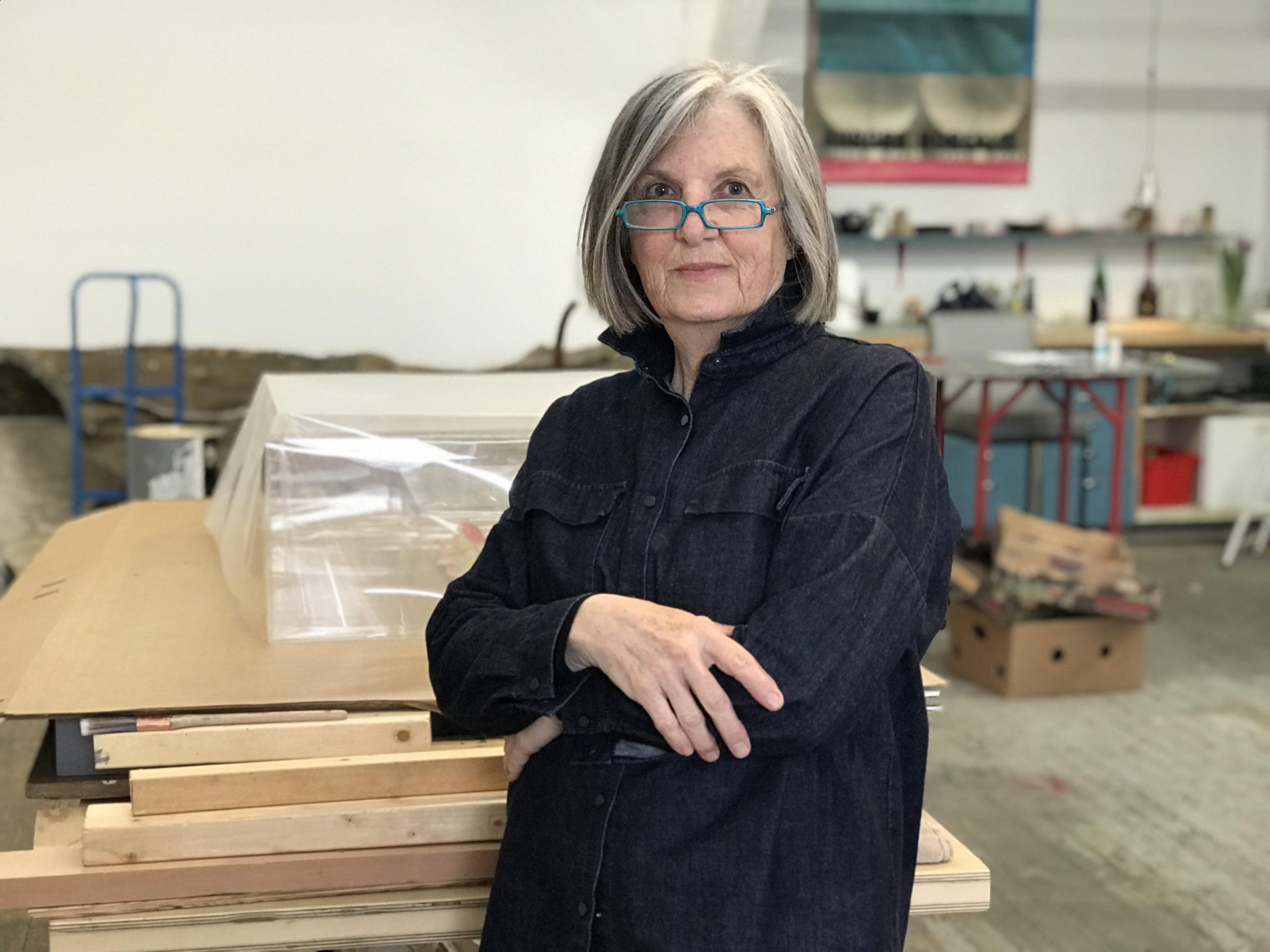
Features #16 — February 2023
Liz Magor in conversation with Nicolas Vamvouklis
I’d like to start with “Carton II,” which is one of my favorite of your works. I believe it is part of what you call “serviceable objects,” suggesting that they act as support structures for other materials. Could you tell me more about this idea?
My work starts with considering the material world; our tools, clothing, toys, etc. We live surrounded by piles of stuff, new things coming in and old things heading out. Because of the volume and variety of our belongings, much of it exists unnoticed, unused, and maybe even unwanted. The manufactured world has ostensibly come into being to meet our needs and desires. However, no sooner do things arrive than we move past them to desire the next emerging thing. This is interesting to me; the mismatch between the physical world and our metaphysical existence. The expectation that material will substantially alter our psychology is a misunderstanding leading to a kind of “gain then lose” situation that amounts to an endless quest, a sum zero.
Even though we don’t want these things anymore, they don’t cease to exist, and at the point where I encounter them, in the secondary market or the waste stream, their lack of pertinence leaves them free to be reconsidered. Sometimes I develop a new narrative for them, imagining their relationship by imposing a version of social structure onto unrelated objects. This effectively organizes them into subjective situations that include emotions such as dependency, fear, despair, love, dominance, etc. For example, some things, like trays and containers, are in service to their contents, so I exploit that relationship.
In which ways can art facilitate changing the value of objects that come in and out of our lives?
I don’t expect to change how our culture regards manufactured things. I work this way because it gives me agency. I don’t have to renounce my materialism; I get to spend more time with things and do so without personal interest. I can generally acknowledge the phenomenology of my existence.
I remember visiting in 2015 your “Six Ways to Sunday” show at Peep-Hole in Milan. I was mesmerized by your series of blankets alongside other sculptures incorporating fabric samples, clothing, and labels. It was compelling how these very familiar elements reflected not only personal but also collective histories and identities in an unexpected way. What is your idea of intimacy?
Every object has a history; of the origin of its material, its production, its market relevance, its provenance, etc. These are the conventional stories of a thing that are the concern of a museum to research and conserve. I appreciate museums, but I don’t want to operate like that in the studio because the museological approach takes me farther from the reality of a thing rather than closer. When I include labels or signs or identifying badges in a work, I do it in excess so no claim can be true. Probably the basic illogic of a surreal gesture brings me closer to the material simply by banishing the habitual drive to look past the thing in order to know its owner or producer.
Would you say that the artist is a kind of archaeologist? What type of stories do you usually seek to reveal?
I can only speak for myself, and I’m certainly no kind of archaeologist if that is understood to be a study of human history through analyzing artifacts. I’m not looking for human stories, at least not the conventional stories of human exceptionalism that are on repeat. I’m looking for stories of material brilliance, for example; how yarn is amenable to becoming a woven sheet, how the cylindrical form of a cigarette persists even when it is burned to ash, how bags and boxes hold and enhance their contents, how textiles achieve volume and perform as costumes, how paper cups gain strength by rolling their rim, how some materials defy gravity while others reveal its effect.
You are about to open a new exhibition at Marcelle Alix in Paris this February. What is it about?
I have been working with toys for a few years, especially stuffed animals. I’m surprised by how ubiquitous they are and how easily they are employed as emotional surrogates for human feelings. In earlier work, I’ve put them into various situations. They have been the active agents showing care and concern for other objects, or they appear to be the collateral damage of an unregulated drive. In two new works at Marcelle Alix, the stuffies are victims of an accident involving food and takeout containers. It sounds improbable, but it could be true! In another work, the stuffy is having a problem with cardboard packaging.
There are also new works, kind of garment collages, that offer such a plethora of signifiers that the ability of the clothing to secure an identity collapses. At this point, the math of wrinkled fabric can be seen, or the intelligence of a discreet pad in the shoulder or the power of sheer fabric to impart allure. Each collage was done quickly, drawing on a huge pile of unwanted clothes. It was surprising to me how beautiful textiles are when you free them from the job of fashion or style.
Liz, I think you’ve mentioned this ‘freedom’ a couple of times during our conversation. How important is it for you? Do you feel liberated?
It’s possible that I started working in the studio in order to develop a sense of autonomy and personal power. But that was many years ago, several decades ago, actually. By this point, the work of inventing myself, thinking about my identity or status, of whether I’m free or liberated, is well behind me. If I think today about freedom, or more accurately “unfreedom,” it’s not located in the personal but in the social; a consequence of the complex network we emerge from. I use my understanding of this to imagine different part-to-part relationships of things as they operate in a sculpture. I can use the physical quality of things, like gravity, transparency, or flexibility, as analogs to social forces or psychological conditions. So I’m developing a narrative on one level, but it’s a story that is not free to continue without regard for the body or material it finds itself in.
Liz Magor is a Vancouver-based artist who produces sculptural and photographic works concerned with the latent, affective range of familiar materials, images, and objects. Her work was included in major exhibitions such as Documenta VIII, the 41st Venice Biennale, and the 4th Biennale of Sydney. Recent exhibitions include “Downer” at Catriona Jeffries, “I Have Wasted My Life” at Andrew Kreps Gallery, and a new solo exhibition at Marcelle Alix, opening in February 2023. Her touring exhibition “The Rise and The Fall” opens this spring at Focal Point Gallery and travels to Douglas Hyde Gallery and Giuliani Foundation in the summer and fall of 2023.
Liz Magor
Photo Credit
Liz Magor
Installation view: Six Ways to Sunday #06
Peep-Hole, Milan, 2015
Photo: Laura Fantacuzzi – Maxime Galati-Fourcade
Courtesy of Catriona Jeffries, Vancouver
Liz Magor
Maple Leaf
2011
Wool, dye, fabric, metal, plastic, thread
147 x 62 x 10 cm
Courtesy of Catriona Jeffries, Vancouver
Photo: Toni Hafkenscheid
Liz Magor
Carton II
2006
Polymerized gypsum, tobacco, gum, matches, lighters
29 x 53 x 48 cm
Photo: Richard-Max Tremblay
Courtesy of Catriona Jeffries, Vancouver
Collection of Musée d'art contemporain de Montréal
Liz Magor
Coiffed
2020
Painted plywood, fabric skirting, silicone rubber, artificial hair, acrylic throw, woolen blankets, silver fabric, linen, jewelry boxes, costume jewelry, packaging materials
69 x 335 x 244 cm
Photo: Rachel Topham Photography
Courtesy of Catriona Jeffries, Vancouver
Liz Magor
Delivery (brown)
2018
Silicone rubber, textiles, twine
485 x 107 x 107 cm
Photo: Rachel Topham Photography
Courtesy of Catriona Jeffries, Vancouver
Liz Magor
Delivery (brown) (detail)
2018
Silicone rubber, textiles, twine
485 x 107 x 107 cm
Photo: Rachel Topham Photography
Courtesy of Catriona Jeffries, Vancouver
Liz Magor
Installation view: Six Ways to Sunday #06
Peep-Hole, Milan, 2015
Photo: Laura Fantacuzzi – Maxime Galati-Fourcade
Courtesy of Catriona Jeffries, Vancouver
Liz Magor
Leather Palm
2015-2019
Polymerized gypsum, copper, cigarette
8 x 25 x 11 cm
Photo: Rachel Topham Photography
Courtesy of Catriona Jeffries, Vancouver
Photo: Kelly Lycan
BIO
Liz Magor is a Vancouver-based artist who produces sculptural and photographic works concerned with the latent, affective range of familiar materials, images, and objects. Her work was included in major exhibitions such as Documenta VIII, the 41st Venice Biennale, and the 4th Biennale of Sydney. Recent exhibitions include “Downer” at Catriona Jeffries, “I Have Wasted My Life” at Andrew Kreps Gallery, and a new solo exhibition at Marcelle Alix, opening in February 2023. Her touring exhibition “The Rise and The Fall” opens this spring at Focal Point Gallery and travels to Douglas Hyde Gallery and Giuliani Foundation in the summer and fall of 2023.
Liz Magor
Photo Credit
Liz Magor
Installation view: Six Ways to Sunday #06
Peep-Hole, Milan, 2015
Photo: Laura Fantacuzzi – Maxime Galati-Fourcade
Courtesy of Catriona Jeffries, Vancouver
Liz Magor
Maple Leaf
2011
Wool, dye, fabric, metal, plastic, thread
147 x 62 x 10 cm
Courtesy of Catriona Jeffries, Vancouver
Photo: Toni Hafkenscheid
Liz Magor
Carton II
2006
Polymerized gypsum, tobacco, gum, matches, lighters
29 x 53 x 48 cm
Photo: Richard-Max Tremblay
Courtesy of Catriona Jeffries, Vancouver
Collection of Musée d'art contemporain de Montréal
Liz Magor
Coiffed
2020
Painted plywood, fabric skirting, silicone rubber, artificial hair, acrylic throw, woolen blankets, silver fabric, linen, jewelry boxes, costume jewelry, packaging materials
69 x 335 x 244 cm
Photo: Rachel Topham Photography
Courtesy of Catriona Jeffries, Vancouver
Liz Magor
Delivery (brown)
2018
Silicone rubber, textiles, twine
485 x 107 x 107 cm
Photo: Rachel Topham Photography
Courtesy of Catriona Jeffries, Vancouver
Liz Magor
Delivery (brown) (detail)
2018
Silicone rubber, textiles, twine
485 x 107 x 107 cm
Photo: Rachel Topham Photography
Courtesy of Catriona Jeffries, Vancouver
Liz Magor
Installation view: Six Ways to Sunday #06
Peep-Hole, Milan, 2015
Photo: Laura Fantacuzzi – Maxime Galati-Fourcade
Courtesy of Catriona Jeffries, Vancouver
Liz Magor
Leather Palm
2015-2019
Polymerized gypsum, copper, cigarette
8 x 25 x 11 cm
Photo: Rachel Topham Photography
Courtesy of Catriona Jeffries, Vancouver
Photo: Kelly Lycan






















